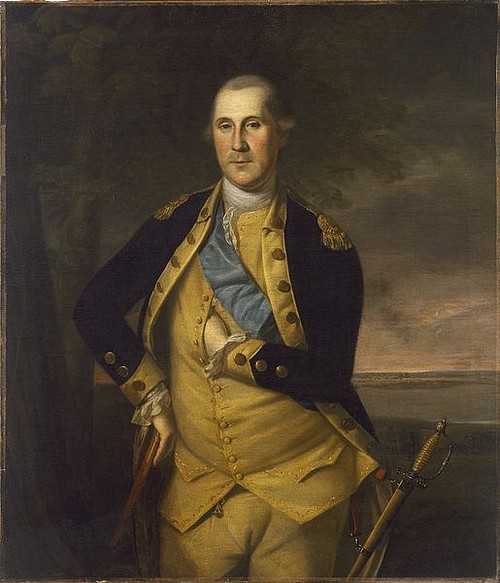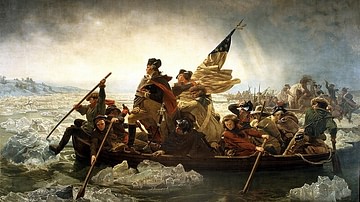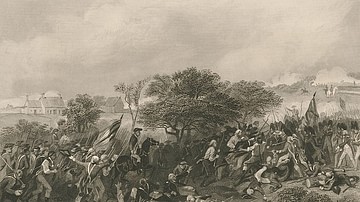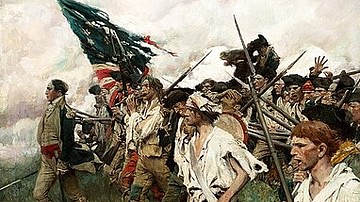The Battle of Long Island (27 August 1776), or the Battle of Brooklyn, was an important battle of the American Revolutionary War (1775-1783). It resulted in the defeat of the Continental Army and led to the eventual British occupation of New York City. It was the first major battle to be fought after the United States' declaration of independence.
Background
On 17 March 1776, the soldiers of the Continental Army watched with elation as the last of the British warships slipped out of Boston Harbor, their white sails growing increasingly distant before finally disappearing beyond the horizon. After nearly eleven months of tedious siege, the town of Boston was once again in American hands and the newly formed Continental Army had passed its first test. But the Continental soldiers barely had time to bask in their victory before they were once again on the move. General George Washington, commander of the American army, had long suspected that New York City would be the next target of the British army. Control of the New York port would give the British unimpeded access to the Hudson River, allowing them to invade the American interior. Additionally, the British could use New York as a base from which to launch attacks on Philadelphia, the seat of the Second Continental Congress. Hoping to reach New York before the British, Washington led his army out of Boston on 4 April.
The Continental Army arrived in Manhattan nine days later, numbering approximately 19,000 men, most of whom were from New England. New York City was, at the time, confined only to the upper part of Manhattan Island (then known as York Island) and had a population of about 20,000. Like Boston, it thrived off maritime commerce and shipbuilding, but differed in that it was larger and much more extravagant; Colonel Henry Knox, a Boston native, admired the New York streets that were "much wider than ours," while other soldiers marveled at the elegant buildings and sturdy brick houses (McCollough, 122). Just as New York outstripped Boston in size, so too did it eclipse it in Loyalism; a large portion of the city's residents supported the king's troops and bristled under what they felt was an occupation by an uninvited army.
General Washington established his headquarters at the Archibald Kennedy home on Broadway, where he wasted no time conferring with his second-in-command, General Charles Lee, who had been in New York since February, studying the city's defenses. Lee had become skeptical that the Continentals could properly defend the city without a navy since a British fleet could easily approach the city from multiple different directions; as Lee himself put it, New York was "so encircled with deep navigable water that whoever commands the sea must command the town" (McCullough, 118). But even though the Americans did not yet possess a navy, Washington was adamant about holding New York, arguing that its loss would greatly damage American morale. Lee, therefore, suggested fortifying Brooklyn Heights on Long Island in anticipation of a British landing there. If the Continentals could retain control of Long Island, they stood the best chance of keeping Manhattan, and the Hudson River, out of British hands. Washington agreed and appointed Lee to oversee the construction of the Brooklyn fortifications.

Awaiting the British
Beginning in early May, Washington ferried troops over to the hamlet of Brooklyn to start constructing the fortifications. Lee oversaw the project until he was called away by Congress to take command of the American forces in South Carolina, after which the task of fortifying the heights fell to General William Alexander of New Jersey, better known as Lord Stirling (the title was derived from his ancestral claim to a Scottish earldom). Over the next several weeks, the Continental troops built a square stronghold atop the heights called Fort Stirling that overlooked the East River and New York City. It was supported by three additional forts, each named after a Continental officer; Fort Putnam lay to the left of the heights, the star-shaped Fort Greene was in the center, and Fort Box was built on the right. Each fort was connected by a network of trenches that stretched for over a mile. A fifth fort, Fort Defiance, was constructed on the upper bay while guns were also placed on Governors Island.
As the Continentals were busy fortifying Brooklyn, the situation with the rest of the army in Manhattan was worsening. On 22 April, the mutilated corpses of two Continental soldiers were discovered in a brothel, causing some of their fellow soldiers to riot. General Washington condemned the riots and attempted to combat such disorderly behavior by implementing a curfew and ordering that soldiers would henceforth be punished for drunkenness. Then, a few weeks later, twelve men were arrested in connection to a Loyalist plot to assassinate Washington; those implicated included the mayor of New York, David Matthews, as well as two members of Washington's Life Guard. As the conspirators awaited trial, mobs of infuriated soldiers and Patriots prowled the streets and assaulted known Loyalists, who were beaten, tarred and feathered, and burned with candles. One conspirator, a soldier named Thomas Hickey, was hanged after a court-martial, drawing a large crowd.
In the meantime, every day, the residents of New York awoke half expecting to see the harbor brimming with British warships. To stay as vigilant as possible, Washington doubled the number of men on sentry duty and ordered each soldier to sleep with his weapons at the ready. Houses were stripped of lead to make bullets. Since many of the troops were inexperienced with their muskets, Washington had each man fire two rounds and held drills in which the men would practice running from their camps to the entrenchments atop Brooklyn Heights to help familiarize them with the terrain. But it was not enough. Washington desperately needed more men; having spread his troops thin, he only had around 9,000 men at hand by early June. Thanks to a wave of smallpox that ravaged the army, only around 6,900 of these troops were fit for duty. It was a bleak situation that would only turn more dire on 28 June, when the dreaded day arrived: the British had arrived.
The British Arrive
The first British frigate, the Greyhound, dropped anchor off Staten Island, across the harbor from Washington's position at Brooklyn. It carried General William Howe, who had commanded the British forces in Boston and at the Battle of Bunker Hill, and who was now charged with capturing New York and destroying Washington's army. Within hours, the Greyhound was joined by 44 additional ships commanded by Admiral Lord Richard Howe, the general's elder brother; over the next six weeks, hundreds of British ships anchored in the harbor, creating a forest of masts that blotted out the horizon. The British troops disembarked on Staten Island, where they were given a warm welcome by the island's residents, who were overwhelmingly Loyalist. By mid-August, the British had landed 32,000 soldiers on Staten Island including 8,000 German auxiliary troops known as Hessians. It was the largest expeditionary army Great Britain had ever before assembled.
As the Continentals watched the British forces gather with mounting trepidation, a piece of good news arrived that greatly raised morale: the Continental Congress had declared independence. The soldiers were no longer fighting for an abstract idea of liberty but in the defense of a new nation, the United States of America. On 9 July, Washington assembled his army onto the New York Commons and read aloud the Declaration of Independence; as soon as he finished, a mob consisting of soldiers and Sons of Liberty made their way to the Bowling Green where they pulled down the gilded lead statue of King George III of Great Britain (r. 1760-1820) which was melted down for bullets. The head of the statue was stuck on a pike. In mid-July, the Howe brothers sent a messenger to Washington's headquarters, offering to make peace if the Continentals would lay down their arms and renounce their independence. If these terms were met, the Howes hinted that pardons would be issued. Washington flatly refused, telling the messenger that "those who have committed no fault want no pardon. We are only defending what we deem our indisputable rights" (McCullough, 146).

So, at dawn on 22 August, General Howe began transporting his men from Staten Island to Long Island. Led by generals Sir Henry Clinton and Lord Charles Cornwallis, the British and Hessian troops rowed out in flat bottom boats and disembarked on the shores of Long Island's Gravesend Bay unopposed; by midday, Howe had landed approximately 15,000 men on Long Island. The Loyalist residents of Brooklyn went out to greet them, carrying baskets of food and drink. Initially, Washington hesitated to act, fearing that this was just a ploy to lure more American troops out of Manhattan so that the British could swoop behind and seize New York City, but as more British and Hessian troops began to gather at Gravesend Bay, Washington's hand was forced.
Preparations
Washington ordered six additional regiments to join the 4,000 troops that were already on Long Island. The commander-in-chief then went to Long Island himself to reconnoiter the terrain alongside General Israel Putnam; Putnam had taken command of the Long Island defenses after Washington's first choice for the job, General Nathanael Greene, had fallen dangerously ill. Washington ordered Putnam to position troops on the Heights of Guan as a first line of defense; southeast of the Brooklyn Heights, the Heights of Guan constituted a heavily forested ridge that could provide the American troops with lots of cover. There were three main passes through the heights that the Americans would have to defend. To the west, was the Gowanus Road which was guarded by 500 men under Lord Stirling; at the center was Flatbush Road, which would be defended by 1,000 men under General John Sullivan; at the far east was Bedford Road guarded by 800 men also under General Sullivan. Altogether, the Americans had barely 2,400 men with which to defend the Guan Hills; another 6,000 American soldiers hung back in the Brooklyn forts.
But there was a fourth, narrower pass that went largely ignored by the Continentals: the Jamaica Pass was on the far left of the Guan Heights, three miles (5 km) east of Bedford Road. General Putnam did not expect the British to know about, much less take, this pass and posted only five militia officers to stand guard there. Unfortunately for the Americans, three Loyalists approached British General Clinton and told him of the Jamaica Pass, even offering to guide the British troops through it. Using this information, Clinton approached General Howe with a plan; British General James Grant would make a series of frontal, diversionary assaults on the American positions, while Clinton personally led a force of light infantry up the Jamaica Pass, thereby flanking and surrounding the American troops. This plan carried significant risk; if the Loyalist guides proved untrustworthy, the British could be walking into a trap. Nevertheless, Howe gave his assent, and the British began preparing for an attack.
The Battle
Late in the night of 26 August, the British began to move. General Clinton led the initial column of light infantry, followed closely by Lord Cornwallis with the grenadiers, and finally by General Howe and Lord Hugh Percy leading the main body of troops, a total of 10,000 men. Since the mission depended on stealth, the going was slow, and the soldiers had to travel down narrow back roads. By 3 a.m., Clinton's vanguard reached the Jamaica Pass; the five militia officers Putnam had left to watch the pass were captured without a fight. By dawn on 27 August, Clinton's men had passed through the ravine and emerged at the side of Bedford Road; Clinton ordered them to lay down in the tall grass and wait for his signal.
At 9 a.m., the British began their diversionary attack. At Gowanus Road, at the far right of the American line, Lord Stirling's troops were alerted to the sound of beating drums and blaring fifes as General James Grant's British regulars approached. Spoiling for a fight, Lord Stirling ordered his men into battle lines to give the redcoats "battle in true English taste"; in other words, instead of firing from behind trees and rocks as was the American fashion, Stirling meant to fight out in the open in the European style of battle (McCullough, 172). The British advanced within 200 yards (180 m) of the Continental troops before discharging their muskets; the Americans returned fire. Grant's troops made two assaults against Stirling's line but were repulsed each time. While the Americans felt like they were winning the skirmish, they could not have known that all was going according to Clinton's plan.
Meanwhile, Hessian artillery had been bombarding the American center, at Flatbush Pass, throughout the morning. At 10 a.m., Hessian General Philip von Heister sent in his light skirmishers known as jaegers (literally 'hunters' in German) to begin taking shots at General Sullivan's Continental troops. With the jaegers holding the Americans in place, the British decided to spring the trap; Clinton's troops leaped from their hiding place and slammed into Sullivan's flank. Sullivan's troops swiveled in time to meet this new threat and delivered a devastating volley into the oncoming British troops. As Heister's Hessians moved in to complete the encirclement, the Americans found themselves under fire from all sides. Their line broke as over a thousand Americans began to run in every direction. Hundreds, including General Sullivan himself, were captured; others were left to be beaten or bayoneted to death by the pursuing Hessians. Few would make it back to the safety of Brooklyn Heights unharmed.
As the American left and center crumbled, Lord Stirling soon found that he was on his own. By this time, Stirling's men had been holding their ground for over two hours and had performed bravely, considering that most of them had never been in a battle before, but as the British and Hessians began to close in on all sides, Stirling knew it was time to retreat. Ordering most of his troops to retreat through Gowanus Creek back to Brooklyn, Stirling stayed behind to cover the retreat alongside Major Mordecai Gist and 250 Marylanders. Stirling, Gist, and the Marylanders charged headlong into Lord Cornwallis' grenadiers six times before they were finally broken by overwhelming British fire. Unwilling to let himself be captured by the British, Stirling instead fought his way to the Hessian line before finally surrendering himself to a German officer. Of the 250 Marylanders, only seven, including Major Gist, returned to the American line that evening, the rest having been killed or captured.

Aftermath
By noon, the fighting was over. The Americans had been driven off the Heights of Guan and had suffered egregious losses; almost 2,000 Continentals had been killed, wounded, or drowned in the retreat, while a further 1,000 had been taken prisoner. Many of these prisoners would later die of disease or malnutrition aboard the infamous British prison ships that would soon be anchored off Brooklyn. The British, meanwhile, had lost only 59 killed, 267 wounded, and 31 missing, with the Hessians losing an additional 5 killed and 26 wounded. It had been a resounding British victory; Clinton's plan had gone off flawlessly.
Having taken the Guan Heights, General Howe was now presented with an opportunity: assault the American fortifications on Brooklyn Heights and, if successful, crush the Continental Army once and for all, but Howe hesitated. He let the rest of the day go by without acting and, on 28 August, decided to construct his own breastworks at the foot of the heights, opting to lay siege to the Brooklyn Heights rather than assault them directly. Both contemporary and later historians have puzzled over Howe's logic since he appears to have thrown away a good opportunity for a decisive victory. The most likely reason was that a direct assault on the Brooklyn Heights would have resulted in costly losses; Howe, who was still haunted by the memory of a similar assault on Bunker Hill, would not have wanted a repeat of the slaughter.
The ball, therefore, was now in Washington's court. He was loathe to abandon Long Island without putting up any more of a fight, especially considering the months of work his troops had put into building the fortifications. But, since an American defeat could now spell the end of the infant United States, Washington prudently decided to evacuate Long Island. Amidst a howling storm during the night of 29-30 August, Washington successfully evacuated the Continental troops on Long Island to Manhattan, without alerting the British or losing a single life. The British were stunned, having not expected the Americans to give up their defenses without another fight. The Continental Army remained in New York City until 15 September, when the British successfully landed at Kip's Bay. Washington was then forced to evacuate New York City, which would remain occupied by the British until the end of the war.
The Battle of Long Island proved the largest battle of the Revolutionary War, involving a total of 40,000 troops. It was the first time the Continental Army suffered a major defeat, which had a devastating effect on American morale, leading scores of troops to desert. Washington would experience several more disheartening defeats that autumn during the ensuing New York and New Jersey Campaign before finally turning his luck around at the Battle of Trenton (26 December 1776).










